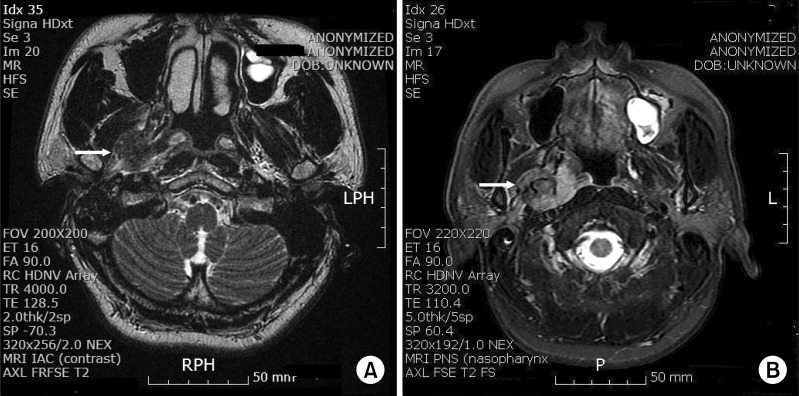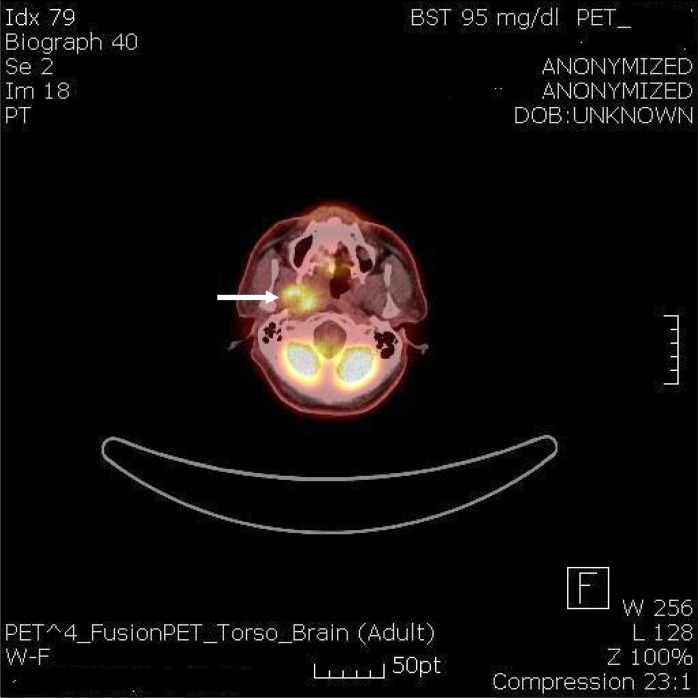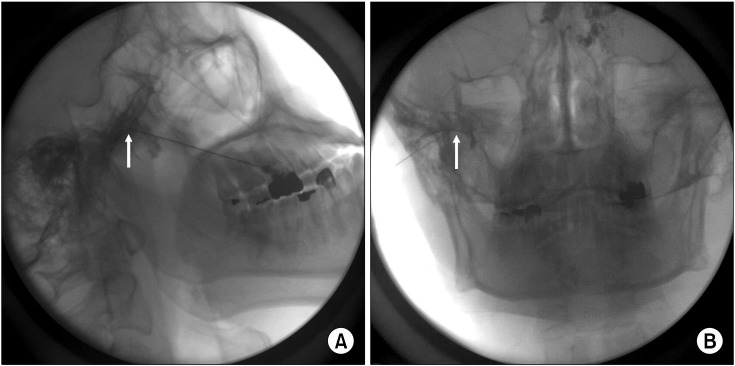Korean J Pain.
2013 Apr;26(2):177-180. 10.3344/kjp.2013.26.2.177.
Secondary Trigeminal Neuralgia Caused by Pharyngeal Squamous Cell Carcinoma: A Case Report
- Affiliations
-
- 1Department of Anesthesiology and Pain Medicine, Seoul National University Hospital, Seoul, Korea.
- 2Department of Anesthesiology and Pain Medicine, Korea University Medical Center, Seoul, Korea. soo02@snu.ac.kr
- 3Department of Anesthesiology and Pain Medicine, Gangneung Asan Hospital, Gangneung, Korea.
- KMID: 1978665
- DOI: http://doi.org/10.3344/kjp.2013.26.2.177
Abstract
- Trigeminal neuralgia (TN) is characterized by recurrent paroxysms of unilateral facial pain that typically is severe, lancinating, and activated with cutaneous stimulation. There are two types of TN, classical TN and atypical TN. The pain nature of classical TN are the same as those described above, whereas atypical TN is characterized by constant, burning pain. We describe the case of a 49-year-old male presenting with right-sided facial pain. The patient was diagnosed with temporomandibular joint disorder at a dental clinic and was on medical treatment, but his symptoms worsened gradually. He was referred to our pain clinic for further evaluation. Radiologic evaluation, including MRI, showed a parapharyngeal tumor. For the relief of TN, a right mandibular nerve (V3) root block was performed at our pain clinic, and then he was scheduled for radiation and chemotherapy.
MeSH Terms
Figure
Cited by 1 articles
-
New insight into the mandibular nerve at the foramen ovale level for percutaneous radiofrequency thermocoagulation
Peng-Bo Zhu, sub, sub, Yeon-Dong Kim, sub, sub, Ha Yeong Jeong, Miyoung Yang, Hyung-Sun Won
Korean J Pain. 2023;36(4):465-472. doi: 10.3344/kjp.23186.
Reference
-
1. Cirak B, Kiymaz N, Arslanoglu A. Trigeminal neuralgia caused by intracranial epidermoid tumor: report of a case and review of the different therapeutic modalities. Pain Physician. 2004; 7:129–132. PMID: 16868626.2. Miller JP, Acar F, Burchiel KJ. Classification of trigeminal neuralgia: clinical, therapeutic, and prognostic implications in a series of 144 patients undergoing microvascular decompression. J Neurosurg. 2009; 111:1231–1234. PMID: 19392593.
Article3. Agrawal M, Agrawal V, Agrawal R, Pramod DS. Trigeminal neuralgia secondary to posterior fossa tumor. Natl J Maxillofac Surg. 2010; 1:71–73. PMID: 22442556.
Article4. Eller JL, Raslan AM, Burchiel KJ. Trigeminal neuralgia: definition and classification. Neurosurg Focus. 2005; 18:E3. PMID: 15913279.
Article5. Klieb HB, Freeman BV. Trigeminal neuralgia caused by intracranial epidermoid tumour: report of a case. J Can Dent Assoc. 2008; 74:63–65. PMID: 18298887.6. Pensak ML, Gluckman JL, Shumrick KA. Parapharyngeal space tumors: an algorithm for evaluation and management. Laryngoscope. 1994; 104:1170–1173. PMID: 8072368.7. Koopman JS, Dieleman JP, Huygen FJ, de Mos M, Martin CG, Sturkenboom MC. Incidence of facial pain in the general population. Pain. 2009; 147:122–127. PMID: 19783099.
Article8. Son DW, Choi CH, Cha SH. Epidermoid tumors in the cerebellopontine angle presenting with trigeminal neuralgia. J Korean Neurosurg Soc. 2010; 47:271–277. PMID: 20461167.
Article9. Peñarrocha-Diago M, Mora-Escribano E, Bagán JV, Peñarrocha-Diago M. Neoplastic trigeminal neuropathy: presentation of 7 cases. Med Oral Patol Oral Cir Bucal. 2006; 11:E106–E111. PMID: 16505784.10. Bisi MA, Selaimen CM, Chaves KD, Bisi MC, Grossi ML. Vestibular schwannoma (acoustic neuroma) mimicking temporomandibular disorders: a case report. J Appl Oral Sci. 2006; 14:476–481. PMID: 19089251.
Article11. Sato J, Saitoh T, Notani K, Fukuda H, Kaneyama K, Segami N. Diagnostic significance of carbamazepine and trigger zones in trigeminal neuralgia. Oral Surg Oral Med Oral Pathol Oral Radiol Endod. 2004; 97:18–22. PMID: 14716252.
Article12. Han KR, Kim YS, Kim C. Clinical features of trigeminal neuralgia. Korean J Pain. 2007; 20:174–180.
Article
- Full Text Links
- Actions
-
Cited
- CITED
-
- Close
- Share
- Similar articles
-
- Meningioma related trigeminal neuralgia presenting as odontalgia: A case report
- A Case of Secondary Trigeminal Neuralgia Caused by Infected Postoperative Maxillary Cyst
- Contralateral Trigeminal Neuralgia Caused by Acoustic Neurinoma
- Trigeminal Neuralgia in a Patient with Osteopetrosis: A Case Report
- Differentiation of Neurological Disorders in Orbital Pain: Focusing on Primary Headache and Trigeminal Neuralgia




